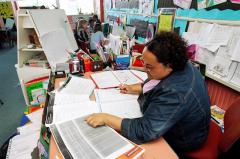You are here:
- Home »
- Using evidence for learning »
- Gathering evidence »
- Types of evidence
Types of evidence

There is a wide range of evidence that schools and teachers can use when inquiring into student learning. The types of evidence detailed here demonstrate this wide range and cover both primary and secondary contexts. Some evidence can be described through a quantifiable number. This is referred to as quantitative evidence or ‘data’. Other evidence is less easy to quantify.This is referred to as qualitative evidence, as it describes a quality that can be difficult to represent in numbers. Both types of evidence are used by schools for decision making.
Quantitative evidence
Student achievement
Evidence about student achievement can include:
- Teacher judgments about where students sit in relation to curriculum expectations, often made twice a year for information sharing with parents and whānau. These are most relevant for students in years 1 to 10. These judgments are made in relation to :
- observation of learning processes
- learning conversations between teachers and students
- student work – work completion rates and patterns, work books, notes, drafts of material, portfolios of work
- assessment tools (for example, e-asTTle or PAT). Schools have a range of assessment tools to choose from. See Selecting an assessment tool.
- National assessment results – NCEA, NZ Scholarship – details like credits above and below year levels, breadth of subjects entered, percentage of Achieved, Merit and Excellence, comparison with national norms.
- Data from previous schools.
Other quantitative evidence
Other quantitative evidence which can be used includes:
- student attendance data
- student retention data
- student engagement data.
Qualitative evidence
To make the most of achievement data to improve learning, teachers need to be aware of many other factors – evidence that describes students’ wider learning environment, and describes a school and its students, staff and community, much of it collected at enrolment and systematically every day.
This evidence tends not to be quantifiable and should be used in conjunction with achievement and possibly other quantitative data to support teacher inquiry.
Demographics
Data that provides a profile of the school (so also known as profile data):
- School – decile, roll size, urban/rural, single-sex or co-educational.
- Students – ethnicity, gender, age, year level, attendance, lateness, suspension and other disciplinary data, previous schools, part-time employment.
- Staff – gender, age, years of experience, qualifications, teaching areas, involvement in national curriculum and assessment, turnover rate.
- Parents/caregivers and community – involvement in the school, socio-economic factors, breadth of school catchment, occupations.
Perceptions
Evidence about what students, staff, parents and the community think about the school. In many schools, there will be few formal records of this sort of evidence.
- Self-appraisal – student perceptions of their own abilities, potential, achievements, attitudes.
- Formal and informal observations made by teachers – peer interactions, behaviour, attitudes, engagement, student-teacher relationships, learning styles, classroom dynamics.
- Structured interactions – records from student interviews, parent interviews, staff conferences on students.
- Externally generated reports – from ERO and NZQA (these contain data and perceptions).
- Student voice – student surveys, student council submissions, conferencing.
- Community perception surveys.
- Other informal sources – anecdotal views about the school environment, staff and student morale, board perceptions, conversations among teachers.
School processes
Evidence about how the school is organised and operates. Some teachers may not think of this as evidence that can be used in decision making, but it is often an important factor in student achievement.
- Timetable – the structure of school day, placement of breaks, subjects offered, tertiary and workforce factors.
- Methods/processes by which students choose their subjects.
- Classes – how they are compiled, their characteristics, effect of timetable choices.
- Resources – access to libraries, textbooks, ICT, special equipment.
- Finance – how the school budget is allocated, how funds are used within departments, expenditure on professional development.
- Staffing – policies and procedures for employing staff, allocating responsibility, special roles, workload, subjects and classes.

